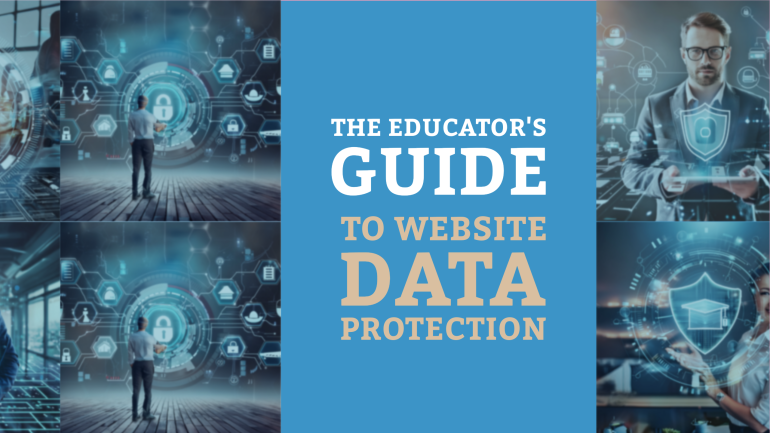This website uses cookies so that we can provide you with the best user experience possible. Cookie information is stored in your browser and performs functions such as recognising you when you return to our website and helping our team to understand which sections of the website you find most interesting and useful.
Table of Contents
You may also interested:
TL;DR: The Educator’s Guide to Website Data Protection
- Implement Privacy Policies: Clearly outline your website’s data collection practices and how the information will be used to increase transparency and build trust with users.
- Secure Data Encryption: Utilize encryption protocols like SSL to protect sensitive data transmitted between your website and users to prevent unauthorized access.
- Regular Data Backups: Ensure that you have a system in place to routinely back up website data to prevent data loss in case of a cyber-attack or technical failure.
- Update Software Regularly: Keep your website’s software, plugins, and security features up to date to patch vulnerabilities and protect against potential security threats.
- Train Staff on Data Protection: Educate your team members on best practices for handling and protecting sensitive data to minimize the risk of breaches due to human error.
There’s a growing need for educators to understand the importance of website data protection in today’s digital age. With the increase in online learning platforms and student information stored digitally, it is crucial to prioritize data security to protect sensitive information from being compromised. This comprehensive guide will provide educators with imperative tips and best practices to ensure website data is secure and safeguarded against cyber threats.
Understanding the Fundamentals
What is Website Data Protection?
One vital aspect of website data protection is safeguarding sensitive information stored on a website from unauthorized access, use, or disclosure. This includes implementing security measures to prevent data breaches and protect the privacy of users.
Types of Data at Risk in Educational Settings
One of the critical components of data protection in educational settings is understanding the types of data that are vulnerable to security threats. Student records, personal information, research data, and financial data are some of the key types of data that are at risk in educational environments. After assessing these risks, appropriate measures can be taken to secure this sensitive information.
Types of Data at Risk in Educational Settings:
| Student records | Personal information |
| Research data | Financial data |
Protection
Website data protection is crucial in educational settings to prevent data breaches that can lead to identity theft, financial fraud, and privacy violations. By implementing encryption, access controls, and regular security audits, educational institutions can ensure the safety of sensitive information.
Legal and Ethical Considerations
Regulations and Compliance Requirements
Some of the most critical aspects educators need to consider when protecting website data are regulations and compliance requirements. For educational institutions, adherence to laws like the Family Educational Rights and Privacy Act (FERPA) and the Children’s Online Privacy Protection Act (COPPA) is crucial. Ensuring that student data is collected, stored, and used in accordance with these laws is non-negotiable to maintain trust and legality.
Ethical Implications of Data Breaches in Education
Some Compliance with ethical standards is imperative when it comes to handling data breaches in educational settings. Data breaches can have far-reaching consequences, not only leading to legal ramifications but also impacting the trust and confidence parents, students, and the community have in the institution. Considerations should include transparency in communication, prompt action to mitigate damages, and a commitment to improving security measures to prevent future incidents.
Strategies for Strengthening Website Data Security
Implementing Robust Security Protocols
One of the most critical steps in safeguarding website data is implementing robust security protocols. This includes using encryption technologies, updating software regularly, and enforcing strong password policies. By putting these measures in place, you can significantly reduce the risk of unauthorized access to sensitive information.
Educating Staff and Students on Data Protection
On ensuring website data security, educating staff and students on data protection is important. Provide training on recognizing phishing attempts, the importance of not sharing passwords, and how to handle sensitive information securely. By raising awareness and promoting a culture of data security, you can create a stronger defense against potential threats.
Protocols: It is crucial to emphasize the significance of data protection to all individuals who interact with the website. Encourage staff and students to report any suspicious activity immediately and provide clear guidelines on proper data handling procedures. By instilling a sense of responsibility and accountability, you can enhance overall data security posture.
Tools and Resources
Security Software for Educational Institutions
On your quest to protect sensitive data on your educational institution’s website, investing in robust security software is a crucial step. Look for tools like firewalls, encryption software, and malware detection programs specifically designed for educational institutions. These software solutions can help in safeguarding student records, financial information, and other confidential data from cyber threats.
Best Practices for Regular Data Security Audits
Security audits are important to ensure that your website’s data protection measures are up to date and effective in thwarting potential cyber breaches. Regularly scheduled audits can uncover vulnerabilities and gaps in your security protocols, allowing you to address them promptly. Consider partnering with cybersecurity experts or using automated tools to conduct thorough audits regularly.
Preparing for and Responding to Data Breaches
Developing a Comprehensive Response Plan
Response Plan
To effectively address data breaches, educators must develop a comprehensive response plan that outlines the steps to be taken in the event of a security incident. This plan should include a detailed protocol for identifying, containing, eradicating, and recovering from a breach. It is crucial to designate a response team, establish communication channels, and define roles and responsibilities to ensure a swift and organized response.
Communication and Notification Procedures Following a Breach
Comprehensive
Communication and notification procedures following a breach are critical in maintaining transparency and trust with stakeholders. Educators must have a structured plan in place to inform affected individuals, regulatory bodies, and the public about the breach. Timely and clear communication can help mitigate the impact of the breach and demonstrate proactive efforts to address the situation.
Preparing for a breach involves not only implementing robust security measures but also having a well-thought-out response plan in place. By proactively developing and practicing this plan, educators can effectively mitigate the damages caused by a data breach and safeguard the sensitive information of students and staff.
Conclusion
Now armed with the knowledge and strategies outlined in The Educator’s Guide to Website Data Protection, educators can take proactive steps to safeguard sensitive information online. By implementing best practices such as using secure passwords, educating students on digital literacy, and staying informed about data privacy laws, educators can create a safer digital learning environment for all. Protecting website data is paramount in today’s digital age, and this guide serves as a valuable resource for educators looking to enhance their cybersecurity practices.
FAQ
Q: What is website data protection?
A: Website data protection refers to the practices and strategies put in place to safeguard sensitive information on a website from unauthorized access, use, or disclosure.
Q: Why is website data protection important for educators?
A: Educators deal with a wealth of confidential student and staff information, making them prime targets for data breaches. Ensuring website data protection helps maintain trust, compliance, and reputation.
Q: What are some common threats to website data security for educators?
A: Common threats include hacking attempts, phishing attacks, malware injections, insecure connections, and human error leading to data leaks.
Q: What are best practices for educators to enhance website data protection?
A: Educators can enhance website data protection by implementing HTTPS encryption, using strong passwords, regularly updating software, conducting security audits, and educating staff about cybersecurity best practices.
Q: How can educators respond to a data breach on their website?
A: In the event of a data breach, educators should notify affected parties, contain the breach, assess the damage, improve security measures, and comply with data breach notification laws.





